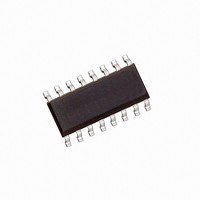HCPL-788J#500 Avago Technologies US Inc., HCPL-788J#500 Datasheet - Page 17

HCPL-788J#500
Manufacturer Part Number
HCPL-788J#500
Description
OPTOCOUPLR AMP CURR SENSE 16SMD
Manufacturer
Avago Technologies US Inc.
Type
Current Sensorr
Datasheet
1.HCPL-788J-000E.pdf
(20 pages)
Specifications of HCPL-788J#500
Voltage - Isolation
3750Vrms
Input Type
DC
Voltage - Supply
4.5 V ~ 5.5 V
Operating Temperature
-40°C ~ 85°C
Mounting Type
Surface Mount
Package / Case
16-SOIC (0.300", 7.5mm Width)
Package Type
SOIC
Operating Supply Voltage (typ)
5V
Lead Free Status / RoHS Status
Contains lead / RoHS non-compliant
Available stocks
Company
Part Number
Manufacturer
Quantity
Price
When laying out a PC board for the current sensing
resistors, a couple of points should be kept in mind.
The Kelvin connections to the resistor should be
brought together under the body of the resistor and
then run very close to each other to the input of the
HCPL-788J; this minimizes the loop area of the con-
nection and reduces the possibility of stray magnetic
fields from interfering with the measured signal. If
the sense resistor is not located on the same PC board as
the HCPL-788J circuit, a tightly twisted pair of wires can
accomplish the same thing.
Also, multiple layers of the PC board can be used to
increase current carrying capacity. Numerous plated-
through vias should surround each non-Kelvin terminal
of the sense resistor to help distribute the current be-
tween the layers of the PC board. The PC board should
use 2 or 4 oz. copper for the layers, resulting in a current
carrying capacity in excess of 20 A. Making the current
carrying traces on the PC board fairly large can also im-
prove the sense resistor’s power dissipation capability
by acting as a heat sink. Liberal use of vias where the
load current enters and exits the PC board is also recom-
mended.
17
Sense Resistor Connections
The recommended method for connecting the
HCPL-788J to the current sensing resistor is shown
in Figure 26. V
nected to the positive terminal of the sense resis-
tor, while V
the power-supply return path functioning as the sense line
to the negative terminal of the current sense
resistor. This allows a single pair of wires or
PC board traces to connect the HCPL-788J circuit to the
sense resistor. By referencing the input circuit to the neg-
ative side of the sense resistor, any load current induced
noise transients on the resistor are seen as a common-
mode signal and will not interfere with the current-sense
signal. This is important because the large load currents
flowing through the motor drive, along with the para-
sitic inductances inherent in the wiring of the circuit, can
generate both noise spikes and offsets that are rela tively
large compared to the small voltages that are being
measured across the current sensing resistor.
If the same power supply is used both for the gate drive circuit
and for the current sensing circuit, it is very important
that the connection from GND
sense resistor be the only return path for supply current
to the gate drive power supply in order to eliminate po-
tential ground loop problems. The only direct connec-
tion between the HCPL-788J circuit and the gate drive
circuit should be the positive power supply line. Please
refer to Avago Technologies’ Applications Note 1078 for
additional information on using Isolation Amplifiers.
IN-
(pin 2) is shorted to GND
IN+
(pin 1 of the HCPL-788J) is con-
1
of the HCPL-788J to the
1
(pin 8), with



















